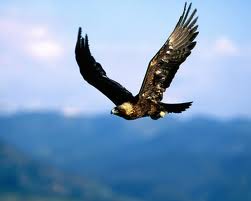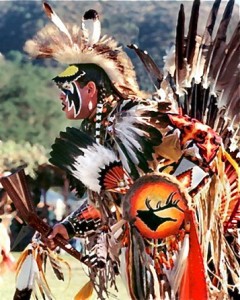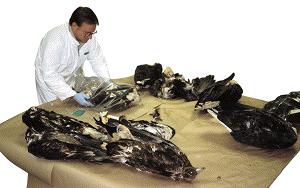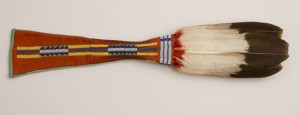According to several recent news reports — here, here, here, and here — the U.S. Fish and Wildlife Service is currently conducting a large-scale undercover investigation targeting people who are illegally buying, selling, or receiving bald and golden eagle feathers.
On March 12, federal agents arrested four men — three from Washington and one from Oklahoma — for killing eagles and selling their feathers. One of the men, Reginald Dale Akeen, an enrolled Kiowa, is accused of traveling the powwow circuit under the name of J. J. Lonelodge and selling illegally obtained feathers to dance competitors for use in their regalia.
 |
| Golden eagle |
While the arrests in Washington and Oklahoma were of Native Americans, the undercover sting operation is apparently more expansive, with agents operating in sixteen states, and targeting both Native and non-Native Americans. Reports of additional arrests and confiscations have been reported on blogs here and here, including the alleged arrest of well-known Diné fan maker Patrick Scott.
There are a number of federal laws addressing the protection of eagles — the Lacey Act, the Migratory Bird Treaty Act, the Endangered Species Act, and the Bald and Golden Eagle Protection Act. The federal agency charged with this protection is the U.S. Fish and Wildlife Service, and its regulations governing the religious use of eagle feathers by Native Americans are found at 50 CFR § 22.22.
Under these regulations, you can legally possess an eagle feather only if you are “an Indian who is authorized to participate in bona fide tribal religious ceremonies” and have received a government-issued eagle permit. To be an Indian you must have the appropriate Certificate of Degree of Indian Blood, and you must be an enrolled member of one of the 562 entities officially recognized by and eligible to receive services from the United States Bureau of Indian Affairs.
Those convicted of possessing eagle feathers without the appropriate permit face imprisonment and fines — as much as two years in prison and a $250,000 fine for a second offense, which is a felony.
The U.S. Fish and Wildlife Service maintains tight control over eagles and eagle feathers. The agency has established a National Eagle Repository at the Rocky Mountain Arsenal National Wildlife Refuge in Denver, Colorado, to provide Native Americans with the feathers of golden and bald eagles needed for religious purposes. The repository serves as a collection point for dead eagles, most salvaged by state and federal wildlife personnel, and most either killed by electrocution, vehicle collisions, or illegal shooting and trapping, or dead from natural causes.
Under the current law, the repository is the only legal source of bald and golden eagle body parts. In order to get an eagle feather legally, you must first obtain an eagle permit from the Fish and Wildlife Service, authorizing you to receive and possess the feather from the repository for religious purposes. Then you have to apply to the repository for the feather. There is currently about a three-and-a-half-year waiting list. More than 5,000 people are standing in line for the approximately 1,000 eagles the repository receives each year.
These rules can have surprising consequences.
 |
| Dancer with eagle feather bustle |
Robert Soto — see here, here, and here — is a holy man of the Lipan Apache. In 2006, during the giveaway ceremony at a powwow in Texas, his eagle feathers were confiscated by an agent of the Fish and Wildlife Service. Soto did not have a permit for the feathers, and he could not get one if he tried. The Lipan Apache are not recognized as a Native American tribe by the Bureau of Indian Affairs.
The rules also make it illegal for anyone — including enrolled members of federally recognized tribes — to possess an eagle feather that has simply fallen on the ground from a live eagle. The rules make it illegal to trade or barter feathers. The rules make it illegal for a Native American to give an eagle feather, as a sign of honor or respect, to a non-Native American, or to a Native American who is not an enrolled member of a federally recognized tribe, or to an enrolled tribal member who does not have a permit. It is illegal for a Native American to give an eagle feather to a non-Native spouse.
And, in some cases, as among the Northern Arapaho of Wyoming, feathers from an eagle killed by an automobile, for example, or by flying into power lines, or by poison, are not considered pure, and cannot be used in the Sun Dance. Instead, the feathers must be from an eagle acquired personally by the sponsor, as a gift of the Creator. The current rules make that impossible.
 |
| The National Eagle Repository |
Clearly there are a number of competing ethical and constitutional values at work here. Although the bald eagle was removed from the endangered species list in 2007, there is every reason to continue to protect eagles and other raptors from poaching. There are good reasons, too, to try to curtail the appropriation of indigenous ceremonies by outsiders to the tradition. That is why many people believe that, after centuries of genocide and marginalization, only enrolled tribal members should be allowed to possess eagle feathers.
Moreover, under both the American Indian Religious Freedom Act and the Religious Freedom Restoration Act, there is every reason to accommodate Native American religious use of eagles and eagle feathers. At the same time, there are legitimate questions raised by restricting that accommodation to a group defined first in racial terms and then by a quintessentially political act of regulatory legitimation.
Courts have differed on whether the Religious Freedom Restoration Act requires the government to open the application process for eagle feathers to Native Americans who are members of tribes that lack federal recognition. Two cases illustrate this conflict. In both, the government argued that it had a compelling interest in preserving the eagle population, and that limiting eagle permits to enrolled members of federally recognized tribes met that goal with the least possible impact on Native American religious practices.
In U.S. v. Hartman (2002), the United States Court of Appeals for the Tenth Circuit held that the government had not presented sufficient evidence to show that expanding the permit system to a member of the federally unrecognized Chiricahua Apache would threaten the eagle population. In fact, the court said, expanding the pool of applicants while the number of permits issued remained constant would at worst add to the delay to applicants, with no effect on eagles.
On the other hand, in U.S. v. Antoine (2003), the United States Court of Appeals for the Ninth Circuit held that the Religious Freedom Restoration Act did not require the government to grant an eagle permit to a member of the federally unrecognized Cowichan Band of the Salish Indian Tribe in British Columbia. “RFRA requires least restrictive means to avoid substantial burdens on religion,” the court stated.
But, in this case, the burden on religion is inescapable; the only question is whom to burden and how much. Both member and nonmember Indians seek to use eagles for religious purposes. The government must decide whether to distribute eagles narrowly and thus burden nonmembers, or distribute them broadly and exacerbate the extreme delays already faced by members. Religion weighs on both sides of the scale. The precise burdens depend on how many nonmember applicants there would be, but not in any illuminating way: Fewer nonmember applicants means shorter additional delays for each member if the restrictions are removed, but also fewer people burdened if they are left in place.
Given this uncertainty regarding Native Americans who are acknowledged members of historical tribes that lack federal recognition, it appears unlikely that the permitting process will be opened any time soon to applicants who are not Native Americans at all.
 |
| Nez Perce beaded eagle feather fan |
One organization, Religious Freedom with Raptors, has proposed replacing the tribal enrollment requirement with a Certificate of Religious Participation endorsed by a tribal member or spiritual leader. Requiring such a certificate, the organization argues, would ensure that only approved participants in bona fide Native American customs are eligible to receive eagle permits, and would allow for direct oversight of eagle feathers to ensure that feathers and ceremonies are not abused. The certificate would thus give legal protection to Native Americans who wish to include others of their choosing in traditional customs involving eagle feathers.
But the organization does not address a further issue. If enrolled tribal members are willing to poach eagle feathers and sell them for money, as is alleged of Reginald Dale Akeen, an enrolled Kiowa, there seems to be little to stand in the way of enrolled tribal members selling Certificates of Religious Participation to outsiders for money as well. While this may reduce poaching — at least for those non-Native Americans actually willing to stand in line for years to get a legal feather — it will, as the Ninth Circuit pointed out, just make the line longer, and increase the wait for everyone.
I would like to think that there is a fair solution to these issues, but I sure don’t know what it is.

- Previous Post: The Last Man
- Next Post: Bioneers
- More Articles Related to: Indigenous Culture, Legal Issues



Interesting. I raised “some” awareness about 2 weeks ago on it and now it seems like there are news stories everywhere. I have some other concerns in this issue tho. Nice blog
I am glad that you are enjoying the blog. I know that this is an issue you have thought about and written about on your own blog. Do you have any thoughts on the best way to handle the current situation?
interesting synopsis. quite to the point. One question i have tho is, does anyone know what happened with the trial with “JJ lonelodge”?
I have tried to follow up, but I have not been able to find any additional information. Sometimes dispositions get a lot less publicity than arrests. I will keep looking, and, if I find out anything new, I will post it on the blog. And welcome! Please feel free to wander around and leave more comments.
I agree with the proposal (Religious Freedom with Raptors) to expand the permitting process to include those who are adopted into a family or tribe and/or are a recognized and integral part of traditional ceremonies.
The issue of selling certificates is a real conundrum because there are so very many false ‘shamans’, ‘medicine’ people and such who would sell certificates just as they sell participation in ceremonies – and sell their own souls in the process. They are answerable for these deeds and I don’t mean to the agents of the US Gov.
I do believe that the sacred protects itself and that one day, we will all be granted our freedom of religious practice. This is my hope and my prayer.
I am fully aware of things going on in and out of pow wow country, NDN country etc. I guess my beef is seeing folks out there that you know are not native at all yet they are sporting feathers and things that the res of us natives might not ever come across. How do these non-natives come by these things and are allowed to use them when our own people get arrested for having these in our possession we are using righteously. I scratch my head in amazement.
its not right .that non native americans ,have eagle feathhers.
Our sacred rituals are important to us, as are animal spirit. The protection of
our birds are important as well. As a native American my people have respected
this land long before the Europeans set foot on turtle island. Now we are told
what we can do and agents can spy on tribal members making feather fans out
of eagles, hawks, and other raptors. Patrick Scott, fan maker was even arrested.
All animals are sacred to natives. We don’t fish for sport. Plants are also sacred
to us, as is the air, the soil, etc. Recently a wandering bison bull was killed by
a so called official and left to rot. An real Indian would not do such a thing.
The fish, game and wildlife let it happen because it cuts into farming and livestock
profit, so it is ok to do so. Take land from people in the Aw’a territory in Brazil
Mine and frack Indian land in the U.S. because it is for profit. Soon the Eagles and other birds will have no trees to nest in, then what? The water will hold no fish.
I have two feathers that I am told are from eagles.
They were in my yard. Am I committing a crime by keeping them, when I don’t even know if they are really from eagles?
We enjoy Eagle Cam-Hanover Pa, but have distorted views since the eaglets have poo-ed on the lens of the camera. We live in Carroll county, MD, just south of the cam in Codorus State Park. As many miles as these birds can fly, it’s within reason that they might have flown this way.